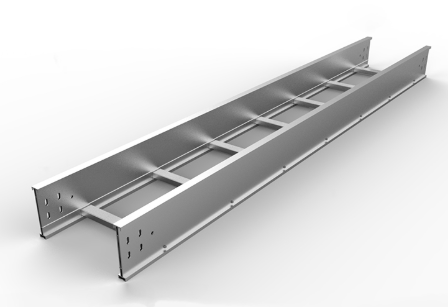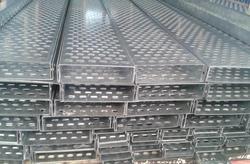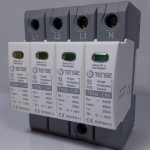What is Cable Tray?
An Electrical cable tray is a type of a containment used to support insulated electrical cables used for power distribution, control, and communication.
Today electrical cable trays have become an integral part of industrial and commercial construction by offering quick, economical and flexible solutions to these problems. Cable trays are capable of supporting all types of wiring:

- High Voltage Power Lines.
- Power Distribution Cables
- Sensitive Control Wiring
- Telecommunication Wiring
- Optical Cables
Type of Cable Trays:
- Cable trays are made of either steel, aluminium or fibber reinforced plastic (FRP) and are available in six basic types,
- Ladder Type Cable Tray
- Solid Bottom Cable Trays
- Perforated Cable Trays
- Channel Cable Trays
- Wire Mesh Cable Trays
- Single Rail Cable Trays
(1) Ladder Type Cable Tray
Generally, Ladder type cable tray is used in applications with intermediate to long support spans 12 to hundreds of feet for heavy cables. However, It is the predominate cable tray type due to its many desirable features:
Why Ladder Type?
A ladder type cable tray without covers allows the maximum free flow of air across the cables. This permits the heat produced in the cables’ conductors to dissipate effectively. Due to these conditions, the insulation of conductor, of a properly designed cable tray wiring system, will not exceed its maximum operating temperature. The life span of cables will be increased due to excessive operating temperatures.
Furthermore,
Cables could be layoff or enter into the ladder cable trays through the top or the bottom of the cable tray. Furthermore, It is moisture free because it can’t accumulate in ladder cable trays.

The most common rung spacing for ladder cable tray is around 9 inches. The spacing in a perforated cable tray supports all sizes of cables.
Read also: Opportunities for Engineers in Construction Sector
(2) Solid Bottom Cable Tray:
Generally used for minimal heat generating electrical or telecommunication applications with short to intermediate support spans 5 to 12 feet.

The main reason for selecting solid bottom cable tray (with covers) is the concern of EMI/ RFI shielding protection for very sensitive circuits. A solid bottom steel cable trays with steel covers provide a good degree of shielding if there are no breaks or holes in the completed installation.
Disadvantage:
The solid bottom cable tray system has a disadvantage in that moisture can build up in the cable trays. Drilling 1/4 inch drain holes in the bottom of the cable tray at three-foot intervals (at the middle and very near the sides) controls the spacing and supports all sizes of cables, but can not used in EMI/RFI Shielding.
The cable trays are just supporting cables designed for such installations. Power Cable failures in cable tray runs rarely happen. Cable failures due to cable support problems in cable trays are nonexistent.
Non-ventilated continuous support for delicate cables with added cable protection available in metallic and fiberglass. However, Solid bottom metallic with solid metal covers for non-plenum rated cable in environmental areas. In addition, standard widths of 6, 12, 18, 24, 30 & 36 inches, standard depths of 3, 4, 5 & 6 inches and standard lengths of 10, 12, 20 & 24 feet.
(3) Perforated Cable Trays
Perforated cable tray have a structure made of metal, typically steel or aluminum, and is designed with a series of evenly spaced perforations or holes along its length which helps to reduce the internal temperature. Generally used for moderate size of cables.

Characteristics:
Moderate ventilation with added cable support frequency with the bottom configuration providing cable support every four inches. Available in metal and nonmetallic materials.
Perforated Cable tray sizes:
Moreover, standard cable tray sizes consist of having standard depth is 3, 4, 5 & 6 inches and standard lengths are 10, 12, 20 & 24 feet. In addition to this, fixed rung spacing of 4 inches on center.
(4) Channel Cable Tray
Used for installations with limited numbers of tray cable when conduit is undesirable. Support frequency with short to medium support spans 5 to 10 feet.
Characteristics:
Economical support for cable drops and branch cable runs from the backbone cable tray system while standard widths of 3, 4, & 6 inches in metal systems and up to 8 inches in nonmetallic systems, standard depths of 1 1/4 to 1 3/4 inches in metal systems and 1, 1 1/8, 1 5/8 in nonmetallic systems, and standard length of 10, 12, 20 & 24 feet.
(5) Wire Mesh Cable Tray
Generally used for telecommunication and fiber optic applications, installed on short support spans—4 to 8 feet.
Characteristics
A job site, field adaptable support system primarily for low voltage, telecommunication and fiber optic cables. However, These systems are typically steel wire mesh, zinc plated while standard widths of 2, 4, 6, 8, 12, 16, 18, 20 & 24 inches; depth of 1,2 & 4 inches and standard length of around 10ft.
(6) Single Rail Cable Tray
Generally used for low voltage and power cable installations where maximum cable freedom, side fill and speed to install are factors.
Characteristics
These aluminum systems are the fastest systems to install and provide the maximum freedom for cable to enter and exit the system. Standard widths, depth and length are 6, 9, 12, 18 inches and 24 ; 3,4 inches and 6; 10 and 12 feet respectively.
Read also: What are Fundamental characteristics of a Circuit Breakers?
Cable Tray Materials:
Most cable tray systems are fabricated from a corrosion-resistant metal (low-carbon steel, stainless steel or an aluminium alloy) or from a metal with a corrosion-resistant finish (zinc or epoxy). The choice of material for any particular installation depends on the installation environment (corrosion and electrical considerations) and cost.
(1) Aluminium:
Aluminium Cable trays are often used for their high strength-to-weight ratio, superior resistance to certain corrosive environments, and ease of installation. Moreover, They also offer the advantages of being light weight (approximately 50% that of a steel trays) and maintenance free, and since aluminium cable trays are non-magnetic. It also reduces electrical losses to minimum.
Cable tray products are formed from the 6063 series alloys. As per design these are copper free alloys for marine applications. These alloys contain silicon and magnesium in appropriate proportions to form magnesium silicate, allowing them to be heat treated. These magnesium silicon alloys possess good formability and structural properties, as well as excellent corrosion resistance.
The unusual resistance to corrosion, including weathering, exhibited by aluminium is due to the self-healing aluminium oxide film that protects the surface. Aluminium’s resistance to chemicals in the application environment should be tested before installation.
(2) Steel:
Steel cable trays are fabricated from structural quality steels using a continuous roll-formed process. Forming and extrusions increase the mechanical strength. The main benefits of steel cable trays are its high strength and low cost. Disadvantages include high weight, low electrical conductivity and relatively poor corrosion resistance.
The rate of corrosion will vary depending on many factors such as the environment, coating or protection applied and the composition of the steel. T&B offers finishes and coatings to improve the corrosion resistance of steel. These include pre-galvanized, hot dip galvanized (after fabrication), epoxy and special paints.
(3) Stainless Steel:
Stainless steel offers high yield strength and high creep strength, at high ambient temperatures. This cable tray is roll-formed from AISI Type 316 stainless steel.
Stainless Steel is resistant to dyestuffs, organic chemicals, and inorganic chemicals at elevated temperatures. Higher levels of chromium and nickel and a reduced level of carbon serve to increase corrosion resistance and facilitate welding.
Read also: How to design an SLD of Electrical Low Voltage (LV) System?
Finishing Processes of Cable Tray
(1) Galvanized Coatings
The most widely used coating for cable tray is galvanizing. It is cost-effective, protects against a wide variety of environmental chemicals, and is self-healing if an area becomes unprotected through cuts or scratches. Steel is coated with zinc through electrolysis by dipping steel into a bath of zinc salts.
A combination of carbonates, hydroxides and zinc oxides forms a protective film to protect the zinc itself. Resistance to corrosion is directly related to the thickness of the coating and the harshness of the environment.
(2) Pre-Galvanized:
Pre-galvanized, also known as mill-galvanized or hot dip mill-galvanized, is produced in a rolling mill by passing steel coils through molten zinc. These coils are then slit to size and fabricated.
Areas not normally coated during fabrication, such as cuts and welds, are protected by neighboring zinc, which works as a sacrificial anode. During welding, a small area directly affected by heat is also left bare, but the same self-healing process occurs.
G90 requires a coating of .90 ounces of zinc per square foot of steel, or .32 ounces per square foot on each side of the metal sheet. In accordance with A653/A653M-06a, pre-galvanized steel is not generally recommended for outdoor use or in industrial environments.
(3) Hot-Dip Galvanized:
After the steel cable tray has been manufactured and assem bled, the entire tray is immersed in a bath of molten zinc, resulting in a coating of all surfaces, as well as all edges, holes and welds.
Coating thickness is determined by the length of time each part is immersed in the bath and the speed of removal. Hot dip galvanizing after fabrication creates a much thicker coating than the pre-galvanized process, a minimum of 3.0 ounces per square foot of steel or 1.50 ounces per square foot on each side of the sheet (according to ASTMA123,grade 65).
The process is recommended for cable trays used in most outdoor environments and many harsh industrial environment applications.
Thermal Expansion and Contraction of Cable Trays:
Thermal expansion and contraction affects the cable trays system. However, it must be taken into account during installation. But, To determine the number of expansion splice plates you need to decide the length of the straight cable tray runs, and the total difference between the minimum winter and maximum summer temperatures.
In order, to function properly, expansion splice plates require accurate gap settings between trays. The support nearest the midpoint between expansion splice plates should be anchored. However, It should also allow the tray longitudinal movement in both directions. Besides, When a cable tray system is used as an equipment grounding conductor. As a result of this, it is important to use bonding jumpers at all expansion connections to keep the electrical circuit continuous.


